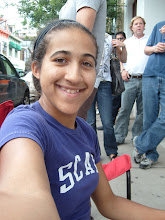Hello World Family,
Falcon here posting a link to the Huffington Post blog by none other than SCAD prez Paula Wallace on Sustainability. Yes, Dove attends SCAD and as a SCAD Mom, I am certainly proud of the university, but it's more than that. They have a plan...and guts. They have a vision, and acumen. Here's what following a 'green' plan for the last 30 years can yield you and your community if your vision is bold, courageous, and encourages progressive thinking. Oh, and there's some serious sweat equity in this venture, too. Savannah has done it, so can you.
Read President Wallace's blog below:
The Greenest Building
In the summer of 1978, the city of Savannah, Georgia, was not doing so well. The iconic downtown department store was shuttered. The Art Deco playhouse was empty. The city's oldest high school, an elegant Greek Revival structure with WPA murals, was abandoned. Young people left and never came back. It was a tired, old, and dying city. Savannah needed ideas, investors, people, something.
I had an idea, and shared it with the mayor.
"We're going to start an art school," I said.
He chuckled. "It won't work," he said. "But go right ahead."
The distinctive architecture of downtown made Savannah the perfect choice for students studying art and design, and the first building of the new Savannah College of Art and Design was a dilapidated volunteer guards armory (a Richardsonian, Romanesque behemoth that seemed way too big at the time). We scrubbed it, restored it, painted it, and hauled in my kitchen table for an admissions desk. Three decades later, we have nearly 10,000 students. And nearly 100 historic buildings at locations in Savannah, Atlanta, Lacoste, and Hong Kong. That downtown department store is now a world-class university library. That Art Deco playhouse is now home to the Savannah Film Festival. That empty high school is now home to SCAD's School of Liberal Arts. Out of nearly a hundred SCAD properties around the world, only four have been newly built.
There's a lot of talk about sustainability these days, and that's a good thing. It's good to grab the low-hanging fruit, like hybrid cars, community gardens, and low-flow plumbing. But real sustainability is systemic and seismic. SCAD didn't start out to become a leader in sustainability. I wish I could claim that kind of prescience. But after we restored our first several historic properties for students, we realized that what we were doing had a name: recycling. Recycling on a monumental scale. As they say, the greenest building is the one that already exists.
But just because SCAD stumbled into its own sustainable practice doesn't mean we can't do it intentionally from here on out. That's why we have embedded sustainable design practices across the curriculum. It's no longer an elective; it's in everything we teach.
At SCAD, interior design and architecture students live and breathe sustainable ideas as naturally as they do building codes. Graphic design students don't just think about how to sell a product with package design - they think about what happens to the package afterwards. Industrial design students travel to Hong Kong and other cities in China to tour manufacturing facilities and learn the names of those who actually fabricate the products. Service design students learn to eliminate paper from the customer experience. Historic preservation students learn to preserve cultures, not just buildings. Fibers students create DIY bedding solutions for the homeless, buildable with thrift-store materials. And there's the new Design for Sustainability degree program at SCAD, where students design water conservation systems in post-Katrina homes and laptop prototypes capable of disassembly.
At SCAD, we teach sustainable design because it gets our students jobs. Aspiring artists and designers need to know how to practice sustainable design, especially when there's an entire summit devoted to the life of a Starbucks cup. Or when a recyclable office chair becomes one of Herman Miller's biggest sellers. Or when the AIA is now requiring annual sustainability education for licensed architects.
Teaching sustainable design also has the added benefit of transforming students into rather brilliant thinkers. That's because sustainable design is nothing less than holistic, productive, and imaginative thinking. In other words, sustainable design is...design. SCAD students are asking big questions, such as, "What are the philosophical assumptions behind this product or service?" and "Is anyone hurt in its manufacture, use, or disposal?" and "How can we save money and people at the same time?" In short, Design for Sustainability is for the 21st century what a degree in philosophy was for the 18th century, providing a healthy, comprehensive worldview. Oh, and employers are desperately seeking leaders who can think in such a way. Just ask Dan Pink, who said, "The MFA is the new MBA."
Sustainable design is about designing a world that's more beautiful, more functional, more equitable. It's about designing something - a world, a city, a product - that lasts. In many respects, this is what SCAD has helped accomplish in the living laboratory of Savannah, and what we're just beginning to do in other communities around the world. Sometimes we stumble into sustainability, looking up and realizing that the smartest decision was the most sustainable one, too. But the next generation of artists and designers won't stumble into it. They will seek out sustainable solutions with clear, purposeful, and imaginative thinking.
Savannah is no longer tired, old, and dying. It is vibrant, reborn, and alive. The change in the city has indeed been seismic. There are jobs. There are young people. There is joy and community. The old buildings are alive with new ideas. That's lasting change, and that's what sustainability is all about. And that's why it's worth teaching to every student.
Read more at: http://www.huffingtonpost.com/paula-wallace/the-greenest-building_b_326018.html
Tuesday, October 20, 2009
'The Greenest Building' by SCAD President Paula Wallace
Posted by
Areya Simmons
at
9:26 AM
1 comments
![]()
Subscribe to:
Comments (Atom)

